Outdoor Education, the Enhancement and Sustainability of Cultural Heritage: Medieval Madrid
Abstract
1. Introduction
- (a)
- From the scientific culture perspective, to favor the approach of valuing heritage, the orientation game helps crystallize knowledge of the territory and the heritage of the place where the method is applied and developed. The aim is that the student appreciates the value of the fieldwork data, which facilitates their understanding of that space. In this process, both digital and spatial skills are improved, since coordinates are understood and managed in a practical way.
- (b)
- From the quality of the teaching-learning perspective, to apply the knowledge acquired in class by linking the classroom or laboratory experience with the real life geographic and historic center of Madrid. Significantly, this is experiential learning in which students interact with each other, and learn in a fun way.
- (c)
- From the socio-emotional perspective, to promote gender equality through groupwork and via the management of technology. The students, without distinction of sex, will experience moving freely and safely through the oldest part of Madrid, learn about its cultural heritage and the evolution of its civilization, thereby fostering responsible citizen awareness in relation to the value and conservation of the past.
2. Methodology
- Selecting participants, who are students undertaking a Master’s degree in ‘Teacher Training for Secondary Education and Baccalaureate in Geography and History’ at Complutense University of Madrid.
- Studying ‘medieval Madrid’, as it seemed appropriate to carry out the activity in the same city as the university.
- Explaining the orientation game to participants.
- Preparing the necessary materials.
- Delivering a questionnaire to participants after the outdoor task. This activity enables student learning to be assessed, and to identify the skills or competences achieved.
2.1. The Orientation Game Design Explained
- Prior to the activity, student motivation and previous knowledge is identified in lectures;
- Key information about the places to visit is gathered and processed (see point 2.1.2) and team groups are organized;
- Fieldwork is undertaken;
- The knowledge acquired after fieldwork is reviewed.
2.1.1. Before Starting the Activity Design: Motivation and Identification of Previous Knowledge
2.1.2. Preparation of the Orientation Game: Collecting and Processing Information
- From a substantive perspective, students work on the city, its historical evolution and the structure that emerges from it, thereby learning about its urban heritage and value. Simultaneously, students are encouraged to apply their heritage learning to other cities that they themselves know.
- From an operational point of view, students learn the techniques necessary to acquire cartographic knowledge, understand a map and orient themselves with it, as well as learn the fundamentals of some global navigation satellite systems available on mobile devices, such as GPS, Galileo and Glonass.
- From a formal perspective, students work on organizing the orientation game in the environment in which it takes place. The future teachers have to establish how the teams should be composed; identify the basic rules of coexistence; establish the rules of the game; and manage their time and ‘space control’—while always taking into account the educational level of those being taught.
2.1.3. Orientation Game: Fieldwork
2.1.4. The Knowledge Attained after the Fieldwork
2.2. Preparation of the Necessary Materials for Development of the Game
2.3. Design of a Questionnaire to Demonstrate the Learning of Future Teachers, Who Are Currently Students
- (a)
- In relation to what has been learned and the orientation game itself:
- Have I learned anything from the activity? If so, briefly state what has been learned.
- Have you completed the activity?
- Have you raised any questions about the activity on the Virtual Campus?
- (b)
- In relation to applied technological skills:
- Has your workgroup employed mobile devices? If so, what did you use them for?
- Did you already know how to use mobile devices for this type of activity?
- (c)
- In relation to the usefulness of the experience:
- Do you consider that the activity has a didactic utility? Why?
- Would you use it in other places? Where?
- Could it be used to acquire new knowledge? What, specifically?
- (d)
- Suggestions for improvement:
- Could the approach to the activity be improved?
- Give examples of the aspects that could be improved.
3. Results
3.1. Quantitative Assessment of the Orientation Game
3.2. Qualitative Assessment of the Orientation Game
3.2.1. Feedback on the Learning Achieved by Future Teachers
- “[I have learned] to merge daily geographical and historical contents of the immediate surroundings, with an itinerary (field trip) and through collaboration to make it meaningful”
- “[I have become more] efficient carrying out an activity in a small part of Madrid, with an entertaining, didactic and physical activity… very interesting”
- “[I was] able to orient myself around Madrid, get to know the historic center of ‘Los Austrias’ and work as a team to understand its cultural and historical significance”
- “I’ve only been in Madrid for a year and this game has helped me to see places that, on my own, I would not have visited, such as the Jewish quarter”
- “I have learned how to participate in a good educational game [and…] develop my skills as a teacher”
- “[I have gained a] new teaching resource to work with students”
- “I have rediscovered the space and the historical monuments, the urban fabric, the origin of the street names, the location of the city walls and their changes...”
- (a)
- Heritage valuation
- (b)
- Assessment of the teaching skills acquired
3.2.2. The Use of Mobile Devices
3.2.3. The Didactic Nature of the Activity as Seen by Future Teachers
- “With mobile devices we have discovered heritage elements in a fun and experiential way that is hard to forget”.
- “It is an experiential practice that integrates theory and practice. We learn in an enjoyable way, which encourages self-discovery and the appreciation of a close environment”.
- By turning the activity into a challenge, “it encourages participants to put in effort. Besides, they are given autonomy and movement, something that completely breaks with the scheme of a theoretical lesson in a classroom”.
- “We have had fun while we have learned and have developed the group by doing the activity together”.
- “We not only use mobile devices and applications in a different way, but we also have learned how to behave and how to organize a group for a didactic fieldwork”.
- “It mixes resources, unites groups and is fun; and at the same time, it allows us to put into practice the contents studied in class”.
3.2.4. The Possibilities to Disseminate the Activity to Other Settings
3.3. Improvable Aspects of the Activity
4. Discussion
5. Conclusions
Author Contributions
Funding
Institutional Review Board Statement
Informed Consent Statement
Data Availability Statement
Acknowledgments
Conflicts of Interest
Appendix A
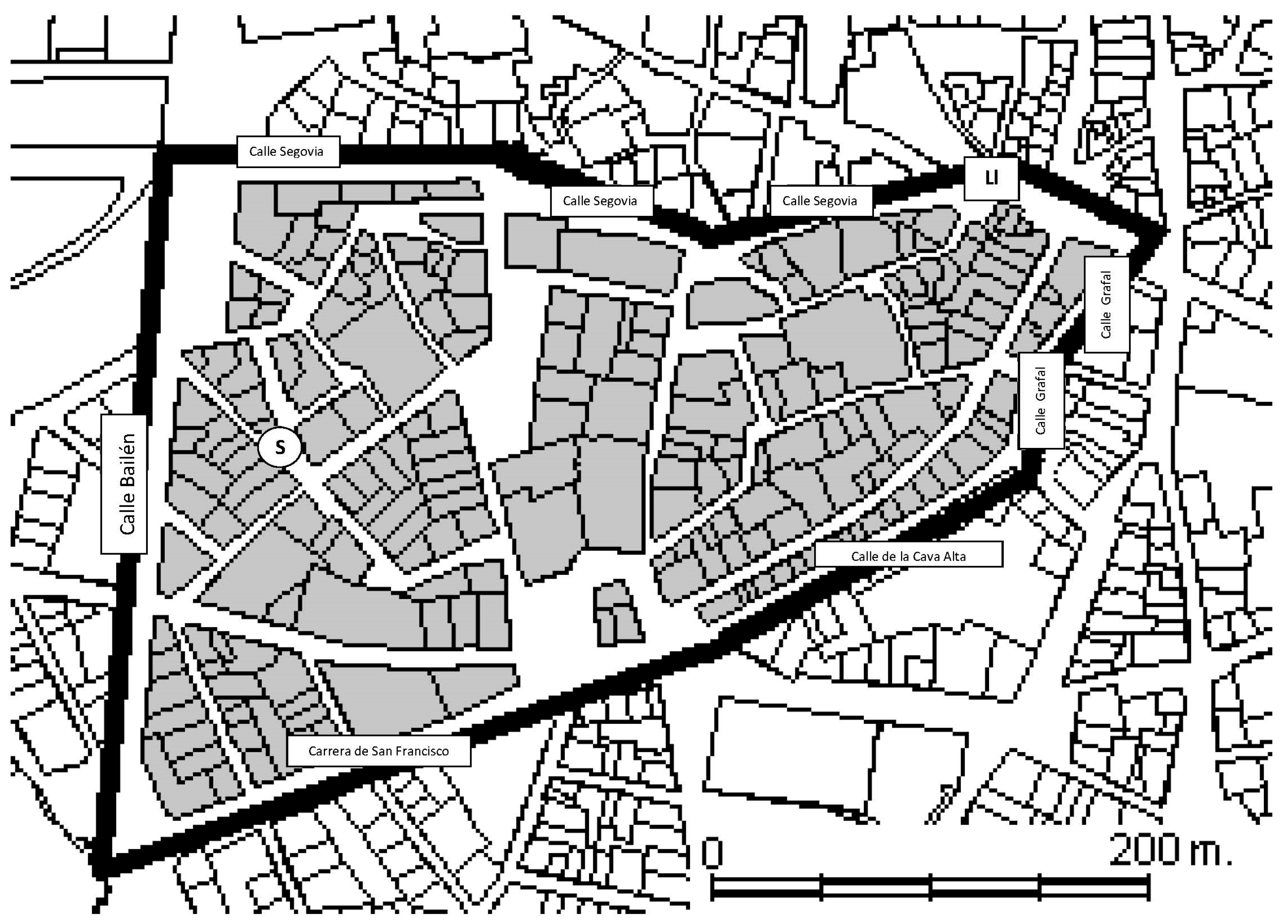
Appendix B
- North: Segovia Street
- West: Bailén Street
- South: Carrera de San Francisco
- SE and East: Cava Alta and Grafal Streets
- -
- Departure or starting point (S): Plaza del Granado (square)
- -
- Your research points:
- Casa del Pastor (House of the Shepherd). Photograph it with at least two members of the group. Answer these questions:Name of the Street it is located on:Coordinates:Locate it on the map as CPastWhat is left of the old building? Why is it called Casa del Pastor?
- Iglesia de San Pedro (San Pedro Church). Photograph it with at least two members of the group. Answer these questions:Name of the Street:Coordinates:Locate it on the map as ISPedro
- -
- Why is this church so important?
- 3.
- Casa-Museo de San Isidro (Museum of San Isidro, his home). Photograph it with at least two members of the group. Answer these questions:Name of the Street:Coordinates:Locate it on the map as CMSIWho was San Isidro? What was his wife’s name?
- 4.
- Capilla del Obispo (Chapel of the Bishop). Photograph it with at least two members of the group. Answer these questions:Name of the square:Coordinates:Locate it on the map as CBishop.What is the artistic style of the building?
- 5.
- Colegio de San Ildefonso (School of San Ildefonso). Photograph it with at least two members of the group. Answer these questions:Name of the Street:Coordinates:Locate it on the map as CSIldWhy is this school so famous?
- 6.
- Jardines del Palacio de Anglona (Gardens of the Palace of Anglona). Photograph it with at least two members of the group. Answer these questions:Names of the square and the street:Coordinates:Locate it on the map as JPAng
- -
- Arrival point (Ll): Puerta Cerrada square
Appendix C
- -
- Management of the game
- -
- Selfie challenge—game solutionsDeparture place: Plaza del Granado (S)Arrival place: Puerta Cerrada (Ll)Difficulty of route: Altitude: between 618 and 646 m
| Treasure | Degrees, Minutes and Seconds | Decimal Degrees | ||
|---|---|---|---|---|
| Casa del Pastor | 40°24′49.09″ N | 3°42′47.80″ W | 40.413649 | −3.713235 |
| Iglesia de San Pedro | 40°24′47.89″ N | 3°42′37.67″ W | 40.413298 | −3.710366 |
| Casa-Museo de San Isidro | 40°24′43.44″ N | 3°42′39.05″ W | 40.412084 | −3.710885 |
| Capilla del Obispo | 40°24′45.04″ N | 3°42′41.76″ W | 40.412457 | −3.711534 |
| Colegio San Ildefonso | 40°24′45.97″ N | 3°42′43.92″ W | 40.412784 | −3.712177 |
| Jardines palacio Anglona | 40°24′48.58″ N | 3°42′41.04″ W | 40.413429 | −3.711422 |
| Treasures | Street/Square | Answers to Questions |
|---|---|---|
1. Casa del Pastor (CPast) | (c) Segovia and Caños Viejos Street | On the building the old shield remains (s.XVII) representing the symbols of the city: the bear and the strawberry tree (madroño).It is called the Casa del Pastor because it was inherited by a shepherd. |
2. Iglesia de San Pedro (el Viejo) (ISPedro)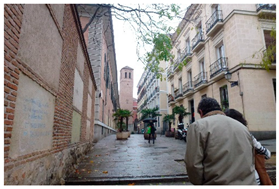 | (c) Nuncio Street | San Pedro church is one of the oldest (s.XIII) mentioned in the Law of Madrid of 1202, as one of its parishes. Its Moorish tower dates back to the fourteenth century, it is built of brick, and the small windows are enhanced with horseshoe arches. |
3. Casa-Museo de San Isidro (CMSI) | Pza. San Andrés square | Saint Isidro was a farmer at the service of the wealthy Vargas family. His wife was called María de la Cabeza and she also became a saint. They are the holy patrons of Madrid. |
4. Capilla del Obispo (Cbishop) | Pza. de la Paja square | The style of the building is gothic-plateresque. |
5. Colegio San Ildefonso (CSIld)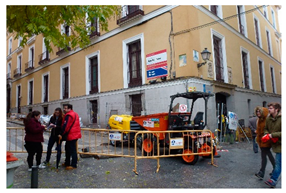 | (c) Redondilla and del Granado Street | It is a European bilingual school that is also famous for the lottery (which is very popular at Christmas). |
6. Jardines palacio Anglona (JPAng)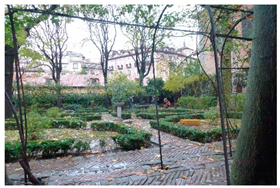 | Pza. De la Paja square and Príncipe de Anglona | The palace has been replaced by a new apartment building |
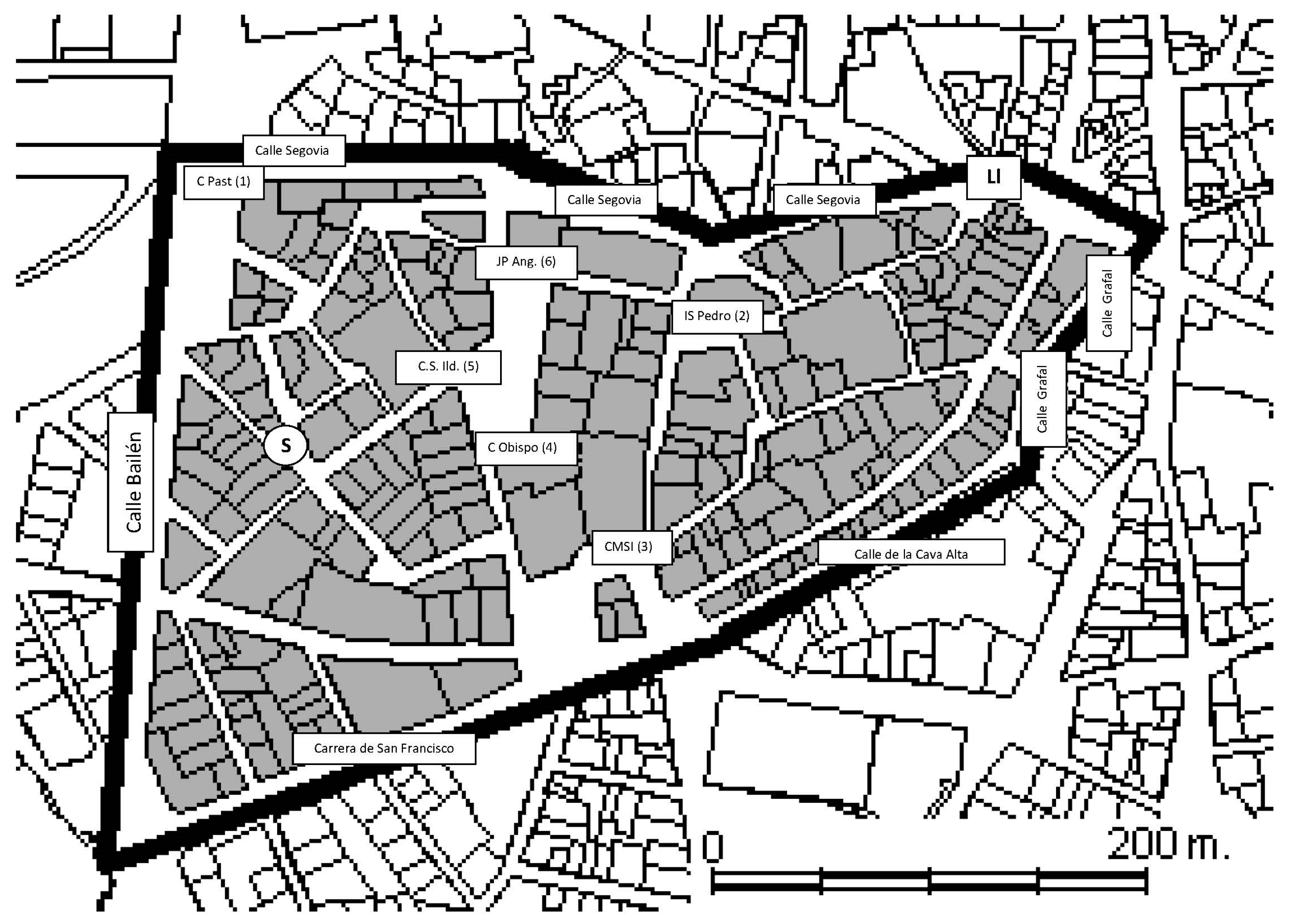
References
- UN. Transforming Our World: The 2030 Agenda for Sustainable Development; United Nations: New York, NY, USA, 2015; Available online: https://sustainabledevelopment.un.org/content/documents/21252030%20Agenda%20for%20Sustainable%20Development%20web.pdf (accessed on 4 January 2021).
- Raszkowski, A.; Bartniczak, B. On the Road to Sustainability: Implementation of the 2030 Agenda Sustainable Development Goals (SDG) in Poland. Sustainability 2019, 11, 366. [Google Scholar] [CrossRef]
- Koch, F.; Krellenberg, K. How to Contextualize SDG 11? Looking at Indicators for Sustainable Urban Development in Germany. ISPRS Int. J. Geo-Inf. 2018, 7, 464. [Google Scholar] [CrossRef]
- Weybrecht, G. From challenge to opportunity-Management education’s crucial role in sustainability and the Sustainable Development Goals-An overview and framework. Int. J. Manag. Educ. 2017, 15, 84–92. [Google Scholar] [CrossRef]
- Quiroz-Niño, C.; Murga-Menoyo, M.Á. Social and Solidarity Economy, Sustainable Development Goals, and Community Development: The Mission of Adult Education & Training. Sustainability 2017, 9, 2164. [Google Scholar] [CrossRef]
- Murga-Menoyo, M.Á.; Correia, F.; Espinosa, Á. Transition towards sustainability in Hull University Business School: A study of curricular sustainability in the teaching processes. In Handbook of Sustainability Science and Research; Springer: Cham, Switzerland, 2018; pp. 783–802. [Google Scholar]
- Borderías Uribeondo, M. Reflexiones al finalizar la “Década de las Naciones Unidas de Educación para el Desarrollo Sostenible 2005–2014”: Referencias ambientales en los Grados de la UNED y aportación de la Geografía a la EDS. Espac. Tiempo Forma Ser. VI Geogr. 2015, 6–7, 19–31. [Google Scholar] [CrossRef][Green Version]
- Fernández-Valencia, A. La ciudad, espacio para el aprendizaje de ciencias sociales y valoración del patrimonio heredado. In El Patrimonio y la Didáctica de las Ciencias Sociales; Ballesteros Arranz, E., Fernández, C.F., Molina Ruiz, J.A., Moreno Benito, P., Eds.; Universidad de Castilla-La Mancha i Asociación Universitaria de Profesores de Didáctica de las Ciencias Sociales: Cuenca, Spain, 2003; pp. 387–398. [Google Scholar]
- Aragoneses, J.; Mínguez, C. The Geographical Systems Information: Tools for the Effective Management of the Cultural Heritage from Natural Disasters. In Geospatial Challenges in the 21st Century; Springer: Cham, Switzerland, 2019; pp. 11–37. [Google Scholar] [CrossRef]
- Estepa, J. La Educación Patrimonial en la Escuela y el Museo: Investigación y Experiencias; Universidad de Huelva: Huelva, Spain, 2013. [Google Scholar]
- Fontal, O.; Ibáñez, A. Estrategias e instrumentos para la educación patrimonial en España. Educ. Siglo XXI 2015, 33, 15–32. [Google Scholar] [CrossRef]
- Fontal, O.; Ceballos, S.G.; Arias, B.; Arias, V.B. Evaluación de la calidad de programas de educación patrimonial: Construcción y calibración de la escala Q-Edutage. Rev. Psicodidact. 2019, 24, 31–38. [Google Scholar] [CrossRef]
- MECD Plan Nacional de Educación y Patrimonio. 2021. Available online: http://www.culturaydeporte.gob.es/planes-nacionales/planes-nacionales/educacion-y-patrimonio.html (accessed on 4 January 2021).
- Observatorio de Educación Patrimonial en España. Available online: http://www.oepe.es/ (accessed on 4 January 2021).
- Fontal, O.; Martínez, M. The Heritage and Education Research Network: Place Value on Cultural Heritage in Europe. In Handbook of Research on Citizenship and Heritage Education; IGI Global: Hershey, PA, USA, 2020; pp. 173–196. [Google Scholar]
- Red Internacional de Educación Patrimonial. Available online: http://www.riep-inhe.com/ (accessed on 4 January 2021).
- Jagielska-Burduk, A.; Stec, P. Council of Europe Cultural Heritage and Education Policy: Preserving Identity and Searching for a Common Core? Rev. Electrón. Interuniv. Form. Profr. 2019, 22, 1–12. [Google Scholar] [CrossRef]
- Fontal, O.; Ibañez-Etxeberria, A. La investigación en Educación Patrimonial. Evolución y estado actual a través del análisis de indicadores de alto impacto Research on Heritage Education. Evolution and Current State Through analysis of High Impact Indicators. Rev. Educ. 2017, 375, 184–214. [Google Scholar]
- Priestnall, G. Landscape Visualization in Fieldwork. J. Geogr. High. Educ. 2009, 33, S104–S112. [Google Scholar] [CrossRef]
- Martín, M.J.; Cuenca, J.M. La Enseñanza y el Aprendizaje del Patrimonio en los Museos: La Perspectiva de los Gestores. Rev. Psicodidáct. 2011, 16, 99–122. Available online: https://ojs.ehu.eus/index.php/psicodidactica/article/view/1114/792 (accessed on 4 January 2021).
- Gómez Ruiz, M.L. El Tratamiento de los Procedimientos en la Geografía del Bachillerato: Nuevas Propuestas de Metodología Activa a Partir de la Investigación Empírica; Colección Digital de Tesis de la Universidad Complutense de Madrid: Madrid, Spain, 2010; Available online: http://eprints.ucm.es/ (accessed on 4 January 2021).
- Lleida, M. El patrimonio Arquitectónico, una Fuente para la Enseñanza de la Historia y de las Ciencias Sociales. Enseñ. Cienc. Soc. 2010, 9, 41–50. Available online: https://www.raco.cat/index.php/EnsenanzaCS/article/view/191357 (accessed on 4 January 2021).
- Gómez Ruiz, M.L. Los Cambios en el Medio Urbano Como Instrumento Didáctico Para Trabajar la Percepción Espacial. In Aportaciones de la Geografía en el Aprendizaje a lo Largo de la Vida; Delgado, J.J., Lázaro, M.L., Marrón, M.J., Eds.; Grupo de Didáctica de la Geografía de la Asociación de Geógrafos Españoles: Sevilla, Spain, 2011; pp. 488–502. Available online: http://didacticageografia.age-geografia.es//docs/Publicaciones/2011_Aportaciones_Geografia.pdf (accessed on 4 January 2021).
- López, C.T. La Enseñanza del Patrimonio a Partir del Entorno Próximo a los Centros Educativos. Análisis Documental. Clío 2013, 39, 1–58. Available online: http://clio.rediris.es/n39/articulos/lopezarroyo.pdf (accessed on 4 January 2021).
- Segrelles, L.M. La Tècnica de L’itinerari Didàctic i la Seua Aplicació al Patrimoni Històric de la Vall D’albaida; Curs Impartit al Centre de Formació de Professorat d’Ontinyent; Centre de Formació de Professorat d’Ontinyent: Ontinvent, Spain, 1996. [Google Scholar]
- Abril Gallego, A.M.; Gallego, A.M.A.; Quesada, M.C.; Rodríguez, A.C.; Bedmar, M.d.C.D.; Carmona, M.D.G.; Martínez, M.V.M.; García, F.J.M.; Rodríguez, M.P.; Balboa, B.R.; et al. El agua: Itinerarios didácticos por el patrimonio histórico-artístico y espacios naturales de la zona de Sierra Mágina (Jaén). In Didáctica de las Ciencias Sociales, Currículo Escolar y Formación del Profesorado. La didáctica de las Ciencias Sociales en los Nuevos Planes de Estudio; Ávila Ruiz, R.M., Alcázar Cruz Rodríguez, M., Díez Bedmar, M.d.C., Eds.; Servicio de Publicaciones de la Universidad de Jaén: Jaén, Spain, 2003; pp. 703–704. [Google Scholar]
- Cruz, L.A. Itinerario Geodidáctico a la Laguna de Peñalara (Madrid). In Aportaciones de la Geografía para Aprender a lo Largo de la Vida; Delgado, J.J., Lázaro, M.L., Marrón, M.J., Eds.; Universidad de Málaga: Málaga, Spain, 2011; pp. 433–446. [Google Scholar]
- Gómez Ruiz, M.L.; Lázaro, M.L.; González, M.J. Impulsar las Competencias Espaciales y Digitales a Través de un Viaje Virtual por Getafe. In La Educación Geográfica Digital; De Miguel, R., De Lázaro, M.L., Marrón, M.J., Eds.; Grupo de Didáctica de la Geografía de la Asociación de Geógrafos Españoles, Universidad de Zaragoza: Zaragoza, Spain, 2012; pp. 471–484. Available online: http://didacticageografia.age-geografia.es/docs/Publicaciones/2012_Educacion_Digital.pdf (accessed on 4 January 2021).
- Crespo, J.M. Un Itinerario Didáctico Para la Interpretación de los Elementos Físicos de los Paisajes de la Sierra de Guadarrama. Didáct. Geogr. 2013, 13, 15–34. Available online: https://didacticageografica.age-geografia.es/index.php/didacticageografica/article/view/94 (accessed on 4 January 2021).
- Alcolea Moratilla, M.A.; Buzo Sánchez, I.; Crespo Castellanos, J.M.; Cruz Naïmi, L.A.; De Lázaro y Torres, M.L.; De Miguel González, R.; Delgado Peña, J.J.; Gómez Ruiz, M.L.; González Castañé, M.; González González, M.J.; et al. Aprender Geografía de España con la Web 2.0; Editorial Universidad Complutense de Madrid, Vicerrectorado de Evaluación de la Calidad de la Universidad Complutense de Madrid: Madrid, Spain, 2014; Available online: http://eprints.ucm.es/27995/ (accessed on 4 January 2021).
- Fuertes, C.; Cantó, J. La tècnica de l’itinerari didàctic en la formació inicial del professorat: Reconstrucció d’una experiencia. @tic. Rev. D’innov. Educ. 2015, 14, 23–30. [Google Scholar] [CrossRef]
- Comănescu, L.; Nedelea, A.; Stănoiu, G. Geomorphosites and geotourism in Bucharest city center (Romania). Quaest. Geogr. 2017, 36, 51–61. [Google Scholar] [CrossRef]
- Crespo Castellanos, J.; Gómez Ruiz, M.; Cruz Naïmi, L. Una aproximación a los Parques Nacionales y sus paisajes a través de itinerarios didácticos. Espac. Tiempo Forma Ser. VI Geogr. 2018, 11, 121–140. [Google Scholar] [CrossRef]
- Mínguez García, M.C. El Paisaje Como Objeto de Estudio de la Geografía. Un Itinerario Didáctico en el Marco de la Semana de la Ciencia de la Comunidad de Madrid. Didáct. Geogr. 2010, 11, 37–62. Available online: https://didacticageografica.age-geografia.es/index.php/didacticageografica/article/view/40 (accessed on 4 January 2021).
- Mínguez García, M. La enseñanza del turismo: Diseño de rutas urbanas usando los GIS Story Maps. Investig. Geogr. 2020. [Google Scholar] [CrossRef]
- García, A. Didáctica del Museo; Ediciones de la Torre: Madrid, Spain, 1998. [Google Scholar]
- Asensio, M.; Pol, E. Nuevos Escenarios en Educación. Aprendizaje Informal sobre el Patrimonio, los Museos y la Ciudad; Aique: Buenos Aire, Argentina, 2002. [Google Scholar]
- García, P.; Martín, P. Museos arqueológicos de Gijón. El patrimonio arqueológico como recurso didáctico. Íber. Didáct. Cienc. Soc. Geogr. Hist. 2009, 59, 53–66. [Google Scholar]
- Fontal, O.; Ibáñez-Etxeberria, A.; Martín, L. Reflexionar Desde las Experiencias. Una Visión Complementaria Entre España, Francia y Brasil. Actas del II Congreso Internacional de Educación Patrimonial; IPCE/OEPE: Madrid, Spain, 2014. [Google Scholar]
- Delgado, J.J.; Fernández, J.C. Spatial skills for the improvement of the quality of life of seniors. Experiences in Málaga and Antequera (Spain). In Geographic and Geolocation Competences for People in Later Life; Delgado, J.J., Ed.; Outdoor ICT Grundtvig Partnership Funded by EACEA (EU Lifelong Learning Programme): University of Málaga: Málaga, Spain, 2013; pp. 80–89. Available online: http://www.e-seniors.asso.fr/OutDoorIctHandbook.pdf (accessed on 4 January 2021).
- Colton Flynn, K.; Popp, J. An Experiential-Based Learning Method Aiming to Improve Spatial Awareness Utilizing GPS, Geocaching, and Geo-Selfies. Geogr. Teach. 2016, 13, 61–71. [Google Scholar] [CrossRef]
- Ibáñez, A.; Vicent, N.; Asensio, M. Aprendizaje Informal, Patrimonio y Dispositivos Móviles. Evaluación de una Experiencia en Educación Secundaria. Didáct. Cienc. Exp. Soc. 2012, 26, 3–18. Available online: https://ojs.uv.es/index.php/dces/article/view/1937/1441 (accessed on 4 January 2021).
- Woodcock, B.; Middleton, A.; Nortcliffe, A. Considering the Smartphone Learner: An Investigation into Student Interest in the Use of Personal Technology to Enhance Their Learning. Stud. Engagem. Exp. J. 2012, 1, 1–15. Available online: http://shura.shu.ac.uk/5256/1/WoodcockSEEJ.pdf (accessed on 20 January 2021).
- Martín Dorta, N.N. Análisis del Uso de Dispositivos Móviles en el Desarrollo de Estrategias de Mejora de las Habilidades Espaciales. Ph.D. Thesis, Universitat Politècnica de València, València, Spain, 2009. [Google Scholar] [CrossRef]
- De Lázaro, M.L.; Alcolea, M.A.; Palacios, M.T. Dispositivos Móviles: Una Herramienta Para el Aprendizaje en Geografía y en los Trabajos de Campo. In Actas del II Congreso Internacional sobre Aprendizaje, Innovación y Competitividad; Fidalgo, A., Sein-Echaluce, M.L., Eds.; Universidad Politécnica de Madrid: Madrid, Spain, 2013; pp. 685–690. Available online: http://138.4.83.137/dmami/documentos/liti/ACTAS_CINAIC_2013.pdf (accessed on 4 January 2021).
- France, D.; Whalley, B.W.; Mauchline, A. From the International Desk: Using Mobile Devices to Enhance Undergraduate Field Research. Council on Undergraduate Research. CUR Q. 2013, 34, 38–42. Available online: http://scholar.google.co.uk/scholar?oi=bibs&hl=en&cluster=2884559852876917386&btnI=Lucky (accessed on 4 January 2021).
- France, D.; Whalley, W.B.; Mauchline, A.; Powell, V.; Welsh, K.; Lerczak, A.; Park, J.; Bednarz, R. Enhancing Fieldwork Learning Using Mobile Technologies; Springer Briefs in Ecology; Springer: Cham, Switzerland; New York, NY, USA, 2015. [Google Scholar] [CrossRef]
- Sebastian, M.; De Miguel, R. Geographical Education 2020: Iberpix and Collector for ArcGIS as Teaching Resources for Spatial Learning. Didáct. Geogr. 2017, 18, 231–246. Available online: https://didacticageografica.age-geografia.es/index.php/didacticageografica/article/view/391 (accessed on 4 January 2021).
- Sebastián-López, M.; de Miguel González, R. Mobile Learning for Sustainable Development and Environmental Teacher Education. Sustainability 2020, 12, 9757. [Google Scholar] [CrossRef]
- Vigotsky, L.S. Pensamiento y Lenguaje; La Pléyade: Buenos Aires, Argentina, 1977. [Google Scholar]
- Novak, J.D. Aprendiendo a Aprender; Martínez Roca: Barcelona, Spain, 1988. [Google Scholar]
- Elosúa de Juan, M.R. El aprendizaje significativo desde un enfoque social. Rev. Psicol. Univ. Tarracon. 1992, 14, 7–16. [Google Scholar]
- Bailey, P. Didáctica de la Geografía; Cincel: Madrid, Spain, 1987. [Google Scholar]
- Liceras, A.; Romero, G. Didáctica de las Ciencias Sociales; Pirámide: Madrid, Spain, 2016. [Google Scholar]
- Centro Nacional de Información Geográfica (CNIG). App Mapas de España. Available online: https://play.google.com/store/apps/details?id=com.orux.oruxmapsIGN&hl=es (accessed on 4 January 2021).
- Summers, M.; Childs, A.; Corney, G. Education for sustainable development in initial teacher training: Issues for interdisciplinary collaboration. Environ. Educ. Res. 2005, 11, 623–647. [Google Scholar] [CrossRef]
- Annan-Diab, F.; Molinari, C. Interdisciplinarity: Practical approach to advancing education for sustainability and for the Sustainable Development Goals. Int. J. Manag. Educ. 2017, 15, 73–83. [Google Scholar] [CrossRef]
- Asmara, C.H.; Anwar, K.; Muhammad, R.N. EFL Learners’ Perception toward an Outdoor Learning Program. International J. Educ. Lit. Stud. 2016, 4, 74–81. Available online: https://www.journals.aiac.org.au/index.php/IJELS/article/view/2430 (accessed on 14 January 2021).
- Alkhafaji, A.; Fallahkhair, S.; Haig, E. A theoretical framework for designing smart and ubiquitous learning environments for outdoor cultural heritage. J. Cult. Herit. 2020, 46, 244–258. [Google Scholar] [CrossRef]
- Cook, V.A.; Phillips, D.; Holden, J. Geography fieldwork in a ‘risk society’. Area 2006, 38, 413–420. [Google Scholar] [CrossRef]
- Fuller, I.C. Taking students outdoors to learn in high places. Area 2012, 44, 7–13. [Google Scholar] [CrossRef]
- Dillon, J.; Rickinson, M.; Teamey, K.; Morris, M.; Choi, M.Y.; Sanders, D.; Benefield, P. The Value of Outdoor Learning: Evidence from Research in the UK and Elsewhere. Sch. Sci. Rev. 2006, 87, 107. Available online: https://www.univie.ac.at/freilanddidaktik/literatur/Dillon_School%20Sc.%20Rev._2006_The%20value%20of%20outdoor%20learning.pdf (accessed on 14 January 2021).
- Morrissey, J.; Clavin, A.; Reilly, K. Field-based learning: The challenge of practising participatory knowledge. J. Geogr. High. Educ. 2013, 37, 619–627. [Google Scholar] [CrossRef]
- Mirrahimi, S.; Tawil, N.M.; Abdullah, N.A.G.; Surat, M.; Usman, I.M.S. Developing Conducive Sustainable Outdoor Learning: The Impact of Natural Environment on Learning, Social and Emotional Intelligence. Procedia Eng. 2011, 20, 389–396. Available online: https://core.ac.uk/download/pdf/82790789.pdf (accessed on 14 January 2021). [CrossRef]
- Madariaga-Orbea, J.M.; Gillate, I.; Ibañez-Etxeberria, A.; Molero, B. Heritage education in informal contexts. Motivation and self-concept/Educación patrimonial en contextos informales. Motivación y autoconcepto. Cult. Educ. 2018, 30, 584–599. [Google Scholar] [CrossRef]
- Kohen-Vacs, D.; Ronen, M.; Cohen, S. Mobile Treasure Hunt Games for Outdoor Learning. Bull. IEEE Tech. Comm. Learn. Technol. 2012, 14, 24–26. Available online: http://tc.computer.org/tclt/wp-content/uploads/sites/5/2018/01/Kohen.pdf (accessed on 14 January 2021).
- Tan, Y.S.M.; Atencio, M. Unpacking a place-based approach—“What lies beyond?” Insights drawn from teachers’ perceptions of Outdoor Education. Teach. Teach. Educ. 2016, 56, 25–34. [Google Scholar] [CrossRef]
- Murga-Menoyo, M.A. Competencias para el desarrollo sostenible: Las capacidades, actitudes y valores meta de la educación en el marco de la agenda global post-2015. Foro Educ. 2015, 13, 55–83. [Google Scholar] [CrossRef]
- Murga-Menoyo, M.A. El camino hacia los ODS: Conformar una ciudadanía planetaria mediante la educación. Comillas J. Int. Relat. 2020, 19, 1–11. [Google Scholar] [CrossRef]
- Tomás, M.P.; Murga-Menoyo, M.A. El marco curricular de la Educación Secundaria Obligatoria: Posibilidades para la formación de competencias en sostenibilidad. Rev. Int. Comun. Desarro. 2020, 3, 90–109. [Google Scholar] [CrossRef]
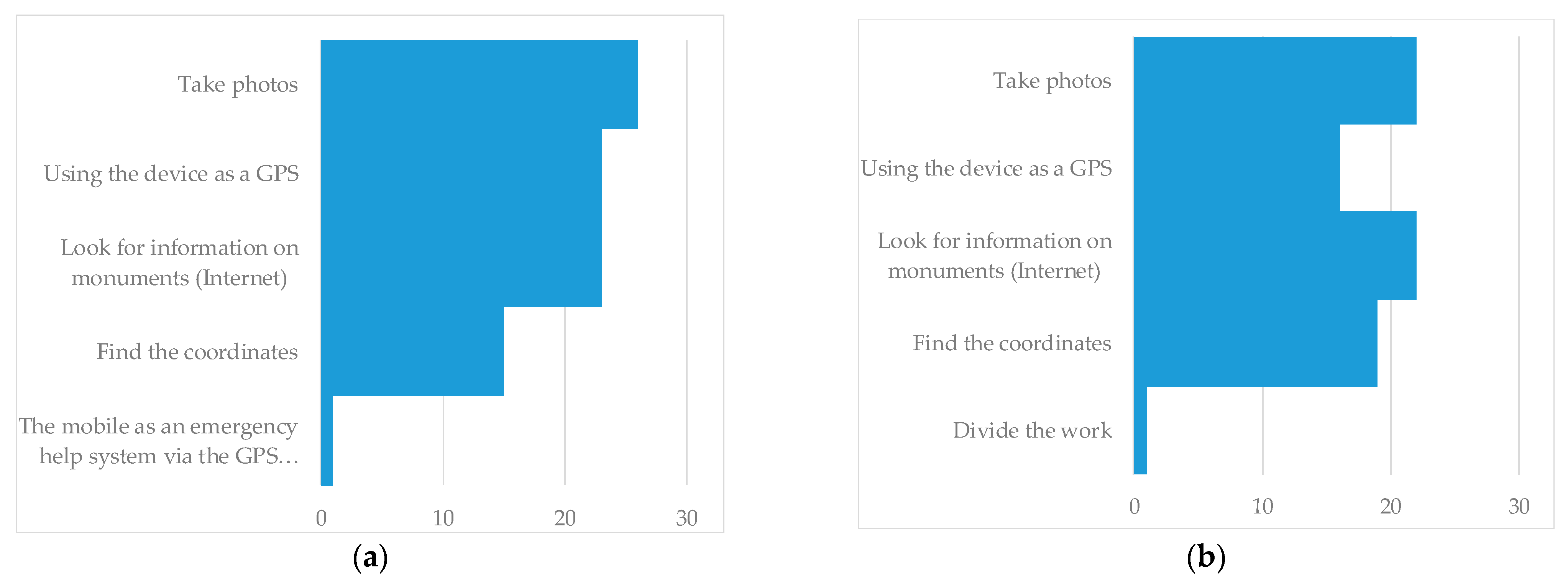
| Year | Men | Women | Total |
|---|---|---|---|
| 2014 | 28 | 24 | 52 |
| 2016 | 17 | 13 | 30 |
| 2018 | 16 | 10 | 26 |
| Total | 61 | 47 | 108 |
| Statements Regarding… | Men (%) | Women (%) | Total (%) | ||||
|---|---|---|---|---|---|---|---|
| What was Learned and the Activity Itself | 2014 | 2016 | 2018 | 2014 | 2016 | 2018 | 2014–2018 |
| I have learned with this activity | 96.43 | 88.24 | 100.00 | 100.00 | 100.00 | 100.00 | 97.22 |
| I have done the full activity | 100.00 | 82.35 | 87.50 | 100.00 | 100.00 | 100.00 | 95.37 |
| I have raised it on the Virtual Campus | 42.86 | 64.71 | 87.50 | 45.83 | 30.77 | 100.00 | 57.41 |
| Applied Technology Skills | |||||||
| Mobile devices have been employed | 96.43 | 88.24 | 100.00 | 100.00 | 100.00 | 100.00 | 97.22 |
| I know how these activities are handled | 92.86 | 88.24 | 87.50 | 79.17 | 92.31 | 100.00 | 88.89 |
| Educational Utility of the Activity | |||||||
| I consider the activity didactic | 92.86 | 100.00 | 100.00 | 95.83 | 100.00 | 100.00 | 97.22 |
| I would extrapolate it to other areas | 85.71 | 94.12 | 93.75 | 95.83 | 76.92 | 90.00 | 89.81 |
| I would use it to learn other things | 85.71 | 76.47 | 93.75 | 91.67 | 92.31 | 100.00 | 88.89 |
| There is something that could be improved | 75.00 | 47.06 | 25.00 | 54.17 | 23.08 | 40.00 | 52.78 |
| I Have Learned | It Can be Learned | Total (%) | |||||||
|---|---|---|---|---|---|---|---|---|---|
| Heritage | 2014 | 2016 | 2018 | Total | 2014 | 2016 | 2018 | Total | Difference |
| About the city of Madrid and its past | 46.15 | 56.67 | 46.15 | 49.07 | 7.69 | 0.00 | 7.69 | 5.56 | 43.52 |
| Integrate valuation of heritage and fun | 7.69 | 10.00 | 7.69 | 8.33 | 0.00 | 0.00 | 0.00 | 0.00 | 8.33 |
| Unique buildings, museums and monuments | 3.85 | 0.00 | 3.85 | 2.78 | 9.62 | 3.33 | 3.85 | 6.48 | −3.70 |
| Heritage content of Social Sciences (art, history, geography), literature, anthropology, music, ecology. | 0.00 | 0.00 | 0.00 | 0.00 | 75.00 | 20.00 | 26.92 | 48.15 | −48.15 |
| Natural heritage (flora, fauna, geology...) | 0.00 | 0.00 | 0.00 | 0.00 | 5.77 | 6.67 | 0.00 | 4.63 | −4.63 |
| Teaching Competencies | |||||||||
| Organize a didactic activity | 28.85 | 30.00 | 57.69 | 36.11 | 0.00 | 0.00 | 0.00 | 0.00 | 36.11 |
| Orientation (spatial competence) | 15.38 | 26.67 | 3.85 | 15.74 | 9.62 | 16.67 | 7.69 | 11.11 | 4.63 |
| Cartography management | 15.38 | 3.33 | 11.54 | 11.11 | 9.62 | 0.00 | 0.00 | 4.63 | 6.48 |
| Manage coordinates to locate a place | 15.38 | 10.00 | 11.54 | 12.96 | 1.92 | 3.33 | 3.85 | 2.78 | 10.19 |
| Teaching app for mobile devices | 7.69 | 0.00 | 0.00 | 3.70 | 1.92 | 0.00 | 0.00 | 0.93 | 2.78 |
| GPS | 11.54 | 0.00 | 0.00 | 5.56 | 0.00 | 3.33 | 0.00 | 0.93 | 4.63 |
| Google Maps | 0.00 | 10.00 | 0.00 | 2.78 | 0.00 | 0.00 | 0.00 | 0.00 | 2.78 |
| Collaborative competition | 9.62 | 3.33 | 3.85 | 6.48 | 1.92 | 3.33 | 7.69 | 3.70 | 2.78 |
| Export and transfer the activity | 5.77 | 0.00 | 0.00 | 2.78 | 0.00 | 0.00 | 0.00 | 0.00 | 2.78 |
| Other Contents | |||||||||
| Observe the environment | 0.00 | 0.00 | 0.00 | 0.00 | 9.62 | 3.33 | 7.69 | 7.41 | −7.41 |
| Town planning | 0.00 | 0.00 | 0.00 | 0.00 | 21.15 | 3.33 | 15.38 | 14.81 | −14.81 |
| Detected contamination | 0.00 | 0.00 | 0.00 | 0.00 | 1.92 | 0.00 | 7.69 | 2.78 | −2.78 |
| Others (economy, tourism, science, mythology, mountain activities, health...) | 0.00 | 0.00 | 0.00 | 0.00 | 5.77 | 0.00 | 11.54 | 5.56 | −5.56 |
| Use of Mobile Devices | No. of Cases | Total (%) |
|---|---|---|
| Information search (Wikipedia, Google Maps, Google Earth) | 10 | 19.23 |
| Take photos (selfie) | 5 | 9.62 |
| Find coordinates | 39 | 75.00 |
| GPS | 9 | 17.31 |
| Other Madrid Districts and Neigbourhood | Madrid Province Municipalities | Other Cities and Towns |
|---|---|---|
| Atocha | Alcalá de Henares | Ávila |
| Arganzuela | Aranjuez | Barcelona |
| Barrio de las Letras | Boadilla del Monte | La Granja (Palacio de) |
| Castellana | El Escorial | Granada |
| Chambería | Getafe | Plasencia |
| Chueca y Malasaña | Móstoles | Salamanca |
| Ensanche barrio Salamanca | Navalcarnero | Segovia |
| Ensanche Argüelles | Seville | |
| La Latina or Lavapiés | Sigüenza | |
| Plaza Mayor | Toledo | |
| Calle de Alcalá and Gran Vía | ||
| El Madrid de los Austrias | ||
| Palacio de Oriente | ||
| Paseo del Prado | ||
| Triángulo del Arte | ||
| Vallecas |
Publisher’s Note: MDPI stays neutral with regard to jurisdictional claims in published maps and institutional affiliations. |
© 2021 by the authors. Licensee MDPI, Basel, Switzerland. This article is an open access article distributed under the terms and conditions of the Creative Commons Attribution (CC BY) license (http://creativecommons.org/licenses/by/4.0/).
Share and Cite
Gómez-Ruiz, M.-L.; Morales-Yago, F.-J.; de Lázaro-Torres, M.-L. Outdoor Education, the Enhancement and Sustainability of Cultural Heritage: Medieval Madrid. Sustainability 2021, 13, 1106. https://doi.org/10.3390/su13031106
Gómez-Ruiz M-L, Morales-Yago F-J, de Lázaro-Torres M-L. Outdoor Education, the Enhancement and Sustainability of Cultural Heritage: Medieval Madrid. Sustainability. 2021; 13(3):1106. https://doi.org/10.3390/su13031106
Chicago/Turabian StyleGómez-Ruiz, María-Luisa, Francisco-José Morales-Yago, and María-Luisa de Lázaro-Torres. 2021. "Outdoor Education, the Enhancement and Sustainability of Cultural Heritage: Medieval Madrid" Sustainability 13, no. 3: 1106. https://doi.org/10.3390/su13031106
APA StyleGómez-Ruiz, M.-L., Morales-Yago, F.-J., & de Lázaro-Torres, M.-L. (2021). Outdoor Education, the Enhancement and Sustainability of Cultural Heritage: Medieval Madrid. Sustainability, 13(3), 1106. https://doi.org/10.3390/su13031106







